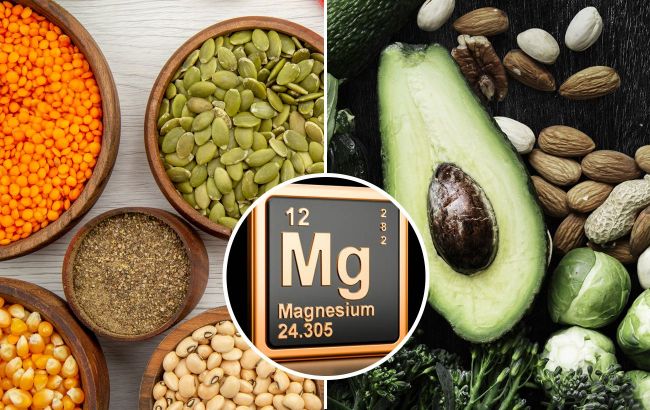Best magnesium-rich foods to include in your diet
 Why human body needs magnesium and where to find it (Collage RBC-Ukraine)
Why human body needs magnesium and where to find it (Collage RBC-Ukraine)
Magnesium is a mineral that your body needs for proper functioning. It helps in hundreds of essential body processes, including those that control muscle and nerve function, writes WebMD.
Why the body needs magnesium
Magnesium helps keep your bones strong, your heart healthy, and your blood sugar levels normal. It also plays a role in your energy level. You can get magnesium in many foods and drinks. But if your doctor thinks you need more, they may suggest you add supplements.
Your body uses magnesium to create new bone cells. Studies show that it may also protect against bone loss, fractures, and osteoporosis. Research indicates that women with osteoporosis usually have lower magnesium levels than those who do not.
Inflammation is your immune system's response to potential harm. In the short term, it helps your body fight viruses and heal wounds. But if you have chronic inflammation, it can lead to health problems such as heart disease, arthritis, and diabetes. Magnesium can help prevent this.
Magnesium helps the heart pump blood. The right level of the mineral can reduce the risk of irregular heartbeat, heart disease, or a heart attack. Magnesium relaxes the walls of blood vessels, helping to lower blood pressure. It can also increase the level of HDL or "good" cholesterol.
Experts believe that magnesium helps block or reduce the level of pain chemicals in the brain and protects blood vessels from narrowing. You are more likely to get migraines if you don't get enough magnesium. Supplements can help relieve these headaches.
Magnesium helps the insulin hormone work correctly. Insulin helps maintain a stable blood sugar level. In one study, people who got the most magnesium in their diet were less likely to get this disease than those who got the least.
How much magnesium do you need?
Adult women need about 310 milligrams of magnesium per day, increasing to 320 milligrams after the age of 30. Pregnant women require an additional 40 milligrams.
Adult men under 31 need 400 milligrams, and those older than 31 require 420 milligrams.
Children need between 30 to 410 milligrams, depending on their age and gender. Consult with your pediatrician to determine the appropriate magnesium intake for your child.
Could there be a magnesium deficiency?
Almost half of the people do not get enough magnesium from their diet. A prolonged low level of this mineral can lead to various health problems, including type 2 diabetes, high blood pressure, and migraines.
Elderly individuals, alcoholics, and people with type 2 diabetes or digestive issues are more likely to have a deficiency, either because their bodies eliminate too much magnesium or because they do not get enough.
If you are healthy, your kidneys excrete excess magnesium obtained from food. However, too much can lead to seizures or nausea. The same applies if you use laxatives or antacids containing magnesium. In very high doses, this mineral can cause serious illness.
Discuss magnesium supplements with your doctor, as some conditions, such as myasthenia, may worsen with their intake.
Foods rich in magnesium
-
Nuts and Seeds: Consuming 30 grams of almonds or cashews provides approximately 80 milligrams of magnesium. Other excellent options include pumpkin seeds, pecans, sunflower seeds, peanuts, and flaxseeds. Sprinkle them on salads or add them to your mix for a heart-healthy dose of fats, fiber, and antioxidants.
-
Whole Grains: Whole grain products surpass white bread and highly processed foods in terms of magnesium content. Two slices of whole grain bread contain 45 milligrams of magnesium, half a cup of brown rice provides about 40 milligrams, and half a cup of cooked oatmeal offers 30 milligrams.
-
Avocado: Regardless of how you slice or mash it, avocado is a fantastic source of magnesium. One cup of diced avocado contains 44 milligrams. Avocado also provides heart-healthy fats, fiber, and folic acid. Try adding avocado to sandwiches, salads, or tacos.
-
Dark Leafy Greens: Another reason to love vegetables. You can get around 150 milligrams from a cup of cooked spinach or Swiss chard. In addition to these two outstanding sources, other magnesium-rich dark leafy vegetables include kale and regular cabbage. Bonus: they are also rich in calcium, potassium, iron, and vitamins A, C, and K. Vegetables don't necessarily have to be leafy; for example, okra is magnesium-rich.
-
Soy Products: Soy is a staple among vegetarians due to its plant-based protein content, but it's also a good source of magnesium. One cup of soy milk contains 60 milligrams, and half a cup of firm tofu provides around 50 milligrams. Try tempeh, made from fermented soy, edamame, and soy yogurt as well.
-
Beans: Only 8% of people consume a serving of beans daily, which means most people lack a healthy magnesium source. Half a cup of black beans contains 60 milligrams, and lentils offer around 35 milligrams. Other magnesium-rich beans include chickpeas, white beans, and kidney beans. From stews to salads, you can add beans to almost any dish, giving you an extra dose of fiber, protein, iron, and zinc.
Earlier, we reported on foods rich in iron and explained why iron deficiency is dangerous.
This material is for informational purposes only and should not be used for medical diagnosis or self-treatment. Our goal is to provide readers with accurate information about symptoms, causes, and methods of detecting diseases. RBС-Ukraine is not responsible for any diagnoses that readers may make based on materials from the resource. We do not recommend self-treatment and advise consulting a doctor in case of any health concerns.

